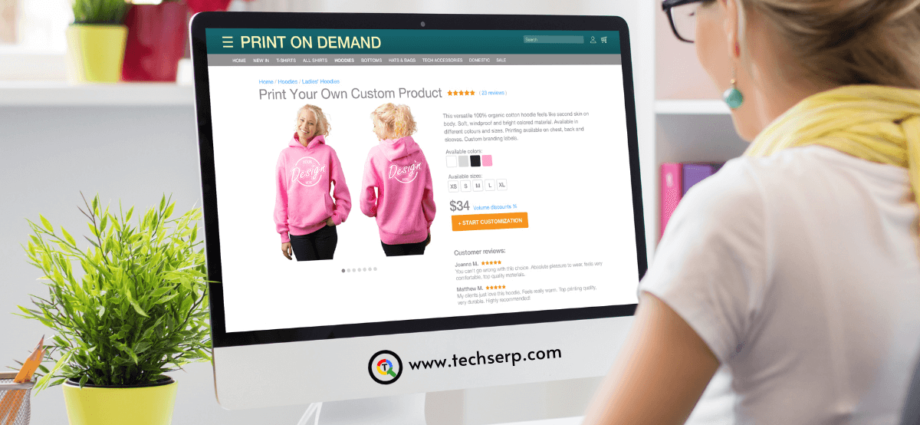Table of Contents
What is Print On Demand (POD)
In the last few years, Print-on-Demand (POD) businesses have gained immense popularity. Entrepreneurs now have the ability to design and sell custom products without worrying about tracking stock or organizing shipping and fulfillment operations. Which can help streamline the whole process and allow them to focus more on core business areas.
This guide is designed to help you launch your own Print On Demand business. It covers topics such as researching product ideas and creating an online store. Follow the steps and tips outlined here, and you’ll soon have a thriving POD business.
Print On Demand-Product Research Ideas
The initial step to setting up a POD business is to do extensive research on potential product ideas. Look at which products are already in demand, analyze current trends, and identify any gaps that your product could fill.
POD products are a great way to make money. And there are several categories to choose from, such as clothing and accessories, home decor items, and phone cases.
Gain motivation and inspiration by looking at the products that successful POD businesses are offering. When it comes to creating successful product ideas, take the risk and don’t be afraid to think outside the box. Be daring and find that competitive edge that sets you apart from your rivals.
Print On Demand-Product Validate Ideas
Before investing too much resources into a project, it is essential to go through the validation process for any product ideas you might have. This can help to avoid any mishaps that may arise due to insufficient or inaccurate research.
To assess the demand for your product, you can build a landing page or social media account and track the engagement from potential customers. This helps to give you a better understanding of consumer interest.
Keyword research is a great way to determine the potential success of your product. It provides an indication of how much people are searching for it, how fiercely other companies are competing for those terms. You can ascertain the general demand and the difficulty level in getting your product to rank on search engines.
Set Up Your Online Store
When choosing a platform, consider factors such as the cost, ease of use, customization options, and integrations with other tools you’ll need for your business, such as payment processors and shipping providers.
When selecting the right platform for your business, there are a few aspects to take into account, such as cost, usability, customizability, and the integrations it offers with other business tools, like payment systems and shipping solutions.
After successfully creating a store, it’s time to start stocking the shelves. The next step in keeping customers satisfied is to add products, compile product information, and set up payment and shipping features.
Create and Source Your Products
Companies have the option to either design their own POD items or source them from a supplier. Both of these solutions offer different benefits and can help businesses save time and money.
Having proficiency in design software, specifically Adobe Photoshop and Illustrator, is essential for working productively. Developing the necessary skills to operate these programs will enable you to create excellent designs with greater ease.
Before you start selling your products, you’ll need to select a POD (Print-on-Demand) provider that works well with your store platform. There are many on the market, some of the most popular ones being Printful, Printify and Teelaunch.
When selecting product sources, it is vital to take into consideration. such as the cost, quality, and delivery speed associated with each vendor. Consider all of these factors when making your decision in order to ensure that you have the best possible combination for your business.
Promote and Market Your Products
After establishing an online store and preparing your products, the next step is to advertise it.
In order to reach the right audience and promote your business, it is crucial to capitalize on the channels they are most active in. Techniques like social media marketing, paid advertising, content marketing & SEO can help you do that. Investing more effort in these tactics will greatly increase your chances of success.
Additionally, leveraging the influence of influencers can be extremely beneficial in helping you reach out to a larger audience.
To maximize the visibility of your products and brand, target platforms where your potential customers spend their time. Additionally, consider engaging with influential figures in your market who can provide endorsements for you.
Track Your Progress and Optimize
Once you enter the world of selling products online, it is essential to track your progress. And make decisions based on analytics data. This will allow you to optimize your business and maximize revenue.
Implementing a tracking system Google Analytics can be extremely helpful in measuring your website’s traffic sales, allowing you to make informed decisions regarding pricing, product offerings, marketing strategies. Taking these steps leads to an efficient and profitable business.
Conclusion:
-
Launching a print-on-demand business can be both rewarding and exciting. It may take some time and money to set up, but having the right strategies and tools in place can help make it a success.
-
With the help of online printing services, inventory management has become much easier. Customers can now avoid the hassle of buying products in bulk by using pre-made templates to creating custom prints for their individual needs. This saves them time and money by avoiding stocking up on items that may never be used.
-
Owning a print-on-demand business can be very rewarding and offer you the flexibility to work at your own pace. With commitment and ingenuity, you can create a successful enterprise that aligns with your individual needs.
You May Also Read: Top 10 Business Ideas to Start Without any Invesment


Comments are closed, but trackbacks and pingbacks are open.